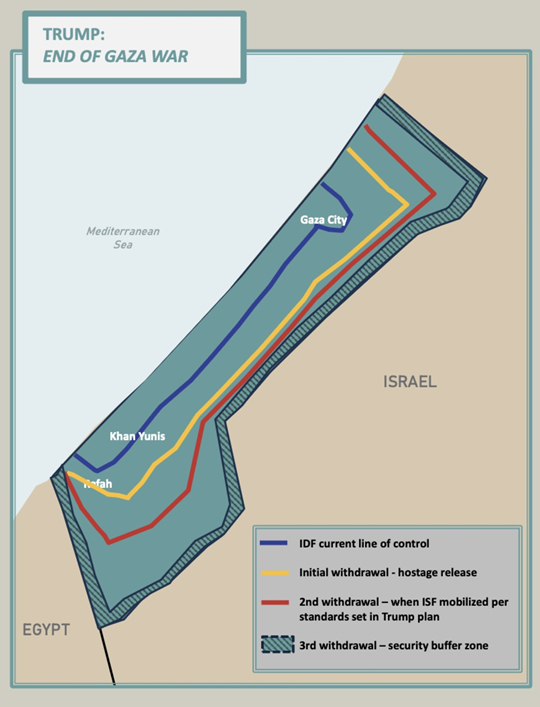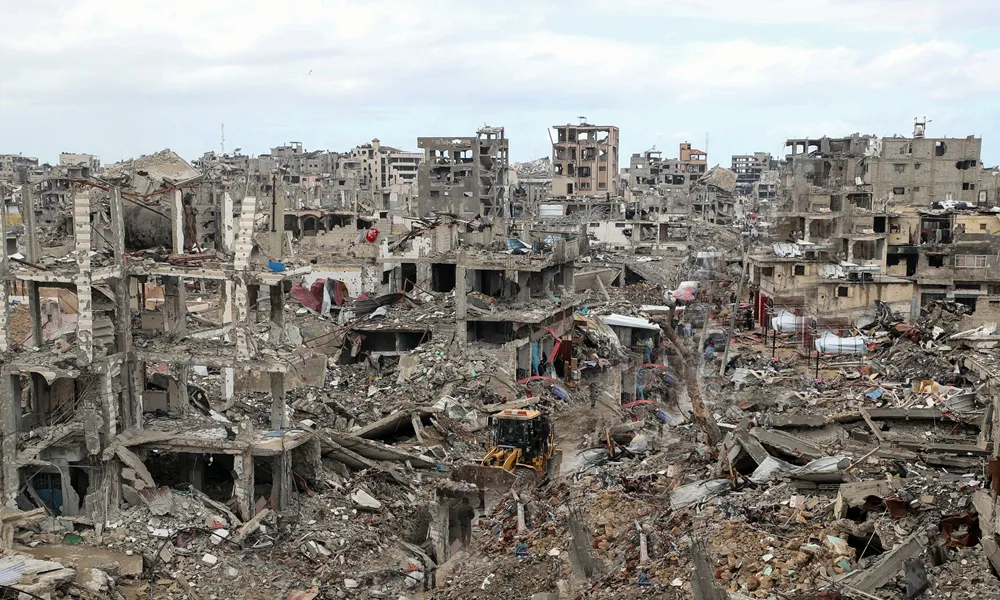Hamas responded on Friday evening to President Donald Trump’s 20-point peace plan for Gaza, welcoming parts of it, opposing other elements and seeking further negotiation.
Trump responded positively, saying he believed Hamas was “ready for a lasting peace” and called on Israel to “immediately stop the bombing of Gaza”.
The US President’s response showed room for manouevre compared to previous statements that suggested the plan was not up for negotiation and that any rejection would raise “all hell” against Hamas, and by association the people of Gaza.
Many questions now remain on whether implementation of the plan will begin or if the ‘grey’ areas of the plan will need to be clarified and negotiated first. The coming days and the next steps taken by Trump, Israel, Hamas and its Arab and Muslim interlocutors will be critical to ending a war that has ravaged the region, upended the norms of international relations and caused unending heartache and loss.
According to reports, Hamas agreed on ending the war, Israel’s “full withdrawal”, the release of Israeli hostages and Palestinian captives, an increase in humanitarian aid, and a commitment not to expel Palestinians from the territory. It appeared to oppose Trump’s plans on the future international governance structure of Gaza that would be headed by Trump and include former British prime minister Tony Blair. Instead, Hamas said it would agree to hand over control to a Palestinian body of independent technocrats “based on Palestinian national consensus and supported by Arab and Islamic backing”. On the issue of Gaza’s future and the legitimate rights of the Palestinian people, a likely reference to Palestinian statehood, Hamas indicated it had no intention of stepping aside, but would continue to have a role in discussions “within a comprehensive Palestinian national framework”.
The plan, submitted on September 29, includes the following basic features: an end to the war; release of all remaining Israeli hostages dead and alive within 72 hours; a later release of nearly 2,000 Palestinian prisoners; the complete disarmament of Hamas members who will have no future role in governing the Strip and an amnesty; humanitarian aid flows; a “temporary transitional governance of a technocratic, apolitical Palestinian committee” to run day-to-day affairs; oversight by an international transitional “Board of Peace” headed by Trump and including Blair which will handle funding for Gaza’s redevelopment; a potential role for the Palestinian Authority subject to reform implementation; a temporary International Stabilization Force (ISF); a commitment by Israel not to occupy or annex Gaza; Israeli military phased withdrawal from Gaza linked to Hamas’ demilitarization, bar military presence in a security buffer zone within Gaza; and a potential pathway to Palestinian self-determination and statehood subject to conditions.

the White House, shows a phased withdrawal of Israeli Defence Forces (IDF)
up to a security perimeter within Gaza
Pressure to end war but fill in gaps
The plan received the backing of most world leaders, including from Arab and Muslim countries. However, some were irked by apparent last-minute changes to the plan made by Israeli Prime Minister Benjamin Netanyahu. Before Hamas’ response on Friday evening, it was not clear whether Trump would give Hamas a similar opportunity to make amendments or tweak aspects of the plan. As for Netanyahu, following the joint announcement of the plan with Trump at the White House, the Israeli PM made it clear in a video that he had no intention of recognising a Palestinian state.
Although Qatar, Egypt and Turkey were applying pressure on Hamas throughout the week to accept the plan, Egyptian Foreign Minister Badr Abdelatty noted on Thursday that the proposal had “a lot of holes that need to be filled”. He referred specifically to issues of “governance and security arrangements”.
News reports varied throughout the week on whether Hamas would accept or reject the plan. The inference was that Hamas negotiators in Doha were more inclined to accept while the military leadership in Gaza less so. Some of the big issues likely to be discussed in the coming days include questions of disarmament, the conditions under which hostages and detainees will be released, Israel’s continued presence or full withdrawal from Gaza, security, governance, Hamas’ future role, and the vague reference to possible statehood.
Asked to comment on the plan, British High Commissioner to Cyprus Michael Tatham said: “The plan has a lot of international support, including from many Arab countries. We’ve been locked in a really bad situation for far too long. This is an opening.
“The right thing to do is seize the opportunity and work as hard as you can to realise the potential for peace and for stabilising the situation.”
Limited options
On the finer details, analysts speaking to Politis raised concerns about the plan though welcomed the effort to end the war.
One analyst who did not wish to be named called for a dose of realism in response to the plan.
“People think international relations is about fairness and just solutions. Wake up. It’s not. Let’s not kid ourselves. Israel is winning the war militarily. If we’re seriously thinking about a settlement, it’s going to be more in Israel’s favour, as it has been since 1948.”
He added that when one side has zero chance of bouncing back, there needs to be a different approach and some “outside of the box” thinking to end the conflict.
‘Half-baked’ plan that can still lead to ceasefire
Gabriel Mitchell, a Visiting Fellow at the German Marshall Fund, told Politis the fact the US managed to secure broad consensus across multiple regional parties on its plan was “no small feat under the circumstances”.
“But as a recipe for success, the Trump plan is only half-baked and lacks the requisite details to fully understand how it would be implemented and to what extent it is feasible,” said Mitchell.
“For these reasons it should be seen for what it is: an effort to compel Israel and Hamas into a ceasefire and save the remaining living hostages before Israel's intended invasion of Gaza City reaches a point of no return,” he added.
On whose authority?
Politis also spoke to a group of observers familiar with international settlement negotiations who did not wish to be named. They highlighted the dearth of legal and political details in the plan. They questioned the international legal basis upon which this international transitional authority – the decision-making body – would oversee Gaza. What is the legal mandate for administering Gaza? The plan also raises issues regarding the legal basis upon which properties in Gaza will be redeveloped, finances handled, and security enforced by multiple actors.
The authority would be governed by a “Board of Peace” that purports to include 10 members and a chairperson (Trump). Including representatives of Arab states on the board would not solve the question of the authority’s “legitimacy”, they argued. What is the legal basis upon which the authority will take decisions on behalf of the people of Gaza? Media leaks also referred to the idea of creating five commissioners to work under the Board, with portfolios related to investment promotion and economic development.
Who handles the money and where does it go?
This raises the issue of the financing of Gaza’s redevelopment. How will the question of legal title of property be dealt with, the observers asked. An issue not unfamiliar to Cypriots. Will this international authority be responsible for financial contributions and capital creation?
What is the mechanism for the interface of the reconstruction board with the people and title holders of Gaza? Under international law and the European Court of Human Rights, Gazans have property rights based on “effective possession” and rights in connection with the concept of “home”.
This raises questions as to who will profit from Gaza’s redevelopment, based on whose consent and with what authority?
Then there is the issue of the “International Stabilisation Force (ISF)” and the question of the right to use force. According to media reports, the ISF will involve some kind of Arab-Israeli military cooperation on issues like counter-terrorism and high-risk threat responses, again raising the question as to the legal basis of such actions.
From recognition to annexation
The plan has many missing parts and is in a legal grey zone, they argued. On the plus side, Middle Eastern powers are willing to work with it. But the Palestinians do not appear to be involved, they said. Should Hamas ultimately reject the plan, the observers argued, then Israel has an opening to proceed with annexation. A threat Israel made when key western powers announced plans to recognise Palestine at the UN General Assembly.
Light on legitimacy and details
James Ker-Lindsay, a long-standing commentator and analyst who runs a popular YouTube channel on international affairs also raised the issue of legitimacy.
The plan may have been put together by third parties, taking Palestinians into consideration, but the fact they were not part of it – neither Hamas nor the Palestinian Authority – removes the legitimacy it could have had if it were truly negotiated, argued Ker-Lindsay.
A second point is that it is very light on details. “Most things in the plan you’d expect to see in a final peace agreement, but it has to be worked on. Instead of 20 points, you’d expect hundreds of pages. To just say, ‘accept these bullet points, and trust us that we’re going to implement it in a certain way,’ given that it’s drawn up by Trump and with Netanyahu in the room, it only compounds the problem.”
What to do with Hamas?
Ker-Lindsay raised the question of security. “How will you make sure it works? Under what mandate? You have to think carefully about the countries going in there. Will they be more acceptable to Palestinians? Are they less likely to be shot at? You need peacekeepers that can build trust and not be an obvious target.”
Other questions that come up are: Who will run Gaza, and will it be from a distance or will Tony Blair move there?
Some may find Hamas to be an appalling organisation, but if they have no role in the administration of the Strip, what does this mean in real terms, asked Ker-Lindsay. Will it have echoes of the ill-judged de-Baathification strategy adopted by the US in Iraq to prohibit Saddam Hussein’s people from any involvement in the new state of affairs? The well-known result of that policy was to set off a deadly insurgency.
“How do you win people over? You provide them with jobs. What do you do with a young Hamas fighter after disarming them and giving them amnesty?”
A permanent wedge between West Bank and Gaza?
On a final and critical point, Ker Lindsay asked: What’s the endgame?
“There is no real engagement on the statehood question. Netanyahu said there will be no recognition. But could this plan ultimately form the basis of a Palestinian state but only in Gaza, leaving the West Bank out?”
The international analyst noted that the history of international administration of territories is not covered in glory. The international community had not planned to give Kosovo statehood before it had implemented certain standards but the Kosovans did not want to wait and made it tricky to refuse them, he said.
“Could the Gazans do the same and demand statehood without the West Bank?”
To read the full text of the 20-point plan, click here.
